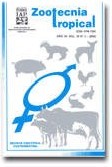
|
Zootecnia Tropical
Instituto Nacional de Investigaciones Agrícolas Venezuela
ISSN: 0798-7269
Vol. 28, No. 4, 2010, pp. 477-487
|
 Bioline Code: zt10047
Bioline Code: zt10047
Full paper language: English
Document type: Research Article
Document available free of charge
|
|
|
Zootecnia Tropical, Vol. 28, No. 4, 2010, pp. 477-487
| en |
Evaluation of mulberry ( Morus alba  ) leaf flour in broiler feeding ) leaf flour in broiler feeding
Ortiz, Mateo Fabian Itzá; Lara, Pedro Enrique; Magaña, Miguel Ángel Magaña & García, José Roberto Sanginés
Abstract
Two experiments were conducted to evaluate the effect of including mulberry leaf flour (MLF) in broiler feeding.
For the first trial 480 male chickens of one day (ISA MPK) were randomly distributed in four treatments with
different feeding flour levels 0 (M0), 4 (M4), 8 (M8) and 12% (M12) and six replicates (n= 20). A lineal (P<0,05)
decrease in body weight as leaf flour increased was observed (2725, 2617, 2482, 2375 g; in M0, M4, M8 y M12,
respectively) and a quadratic effect (P<0,05) in consumption, has be the inflection point on M8. Wherever, the
conversion had a similar response to consumption. Gastrointestinal tract and closed gizzard close weight was
greater (P<0,05) in chickens with 12% of MLF and intermediate with 8%. Carcass yield was 11 % greater in
control group. The second trial consisted in the evaluation of true digestibility (TD) in vivo. The digestibility of
MLF was 32,18% and 17,88% to dry matter and crude protein, respectively. We concluded that levels of 4% of
MLF negatively affect the growth and carcass yield of the chicken; however it can included at 8% in the diet of
chicken over 35 days old. The TD of the protein is low in MLF.
Keywords
digestibility; morera; productive performance; carcass yield
|
| |
| es |
Evaluación de la harina de hoja de morera ( Morus alba  ) en la alimentación de pollos de engorda ) en la alimentación de pollos de engorda
Ortiz, Mateo Fabian Itzá; Lara, Pedro Enrique; Magaña, Miguel Ángel Magaña & García, José Roberto Sanginés
Resumen
Con la finalidad de evaluar el efecto de la inclusión de la harina de hoja de morera (HHM) en la dieta para pollos
de engorda, se realizaron dos experimentos; en el primero se utilizaron 480 pollitos machos (ISA MPK) de un día
de edad los cuales fueron distribuidos al azar en 4 dietas (tratamientos) con base a la inclusión del 4 (M4), 8 (M8)
y 12% (M12) de HHM y un testigo (M0), con 6 repeticiones (n= 20). Se observó una disminución lineal (P<0,05)
en el peso corporal (49 días) a medida que se incrementó la HHM (2725, 2617, 2482, 2375 g; para M0, M4, M8
y M12, respectivamente) y un efecto cuadrático (P<0,05) en el consumo, siendo el punto de inflexión en M8. El
peso del tracto gastrointestinal y molleja cerrada fue mayor (P<0,05) en el tratamiento M12 e intermedio en M8.
Tanto el perímetro del muslo como el rendimiento de la canal fueron 11% mayores (P<0,05) en la dieta testigo.
El segundo experimento consistió en evaluación de la digestibilidad verdadera (DV) in vivo. La digestibilidad de
la HHM fue 32,18% y 17,88%, para la materia seca y proteína, respectivamente. Se concluye que HHM a niveles
mayores del 4% afecta negativamente el desarrollo y rendimiento de la canal del pollo de engorda; sin embargo,
puede incluirse al 8% en la dieta de pollos mayores de 35 días. La DV de la proteína de la HHM es baja.
Palabras-clave
digestibilidad; comportamiento productivo; morera; rendimiento de canal
|
| |
© Copyright 2010- Zootecnia Tropical
Alternative site location: http://www.sian.inia.gob.ve/repositorio/revistas_ci/ZootecniaTropical/ztindice.htm
|
|
